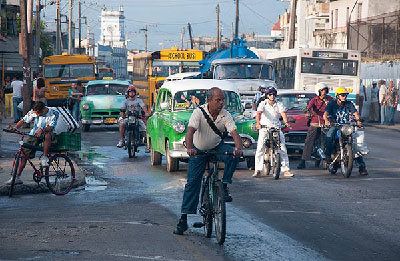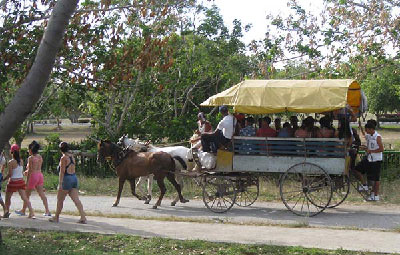Cuba’s Public Transport System: Adjustments are not Enough

HAVANA TIMES — Fifty years of unsuccessful attempts at re-structuring its public transportation into a system that works should suffice to make Cuba consider changing the very foundations of the system. The “reorganization” being proposed today promises to be more of the same and is not likely to yield the quality services aimed for.
The last meeting held by Cuba’s Council of Ministers publicly recognized that the country’s transportation system “has been unstable, inadequate and low-quality for years.” The common Cuban who “hops on a bus” every day has something similar to say, albeit with far less refined words.
“Updates” can help steer those sectors that actually work, such as public health, education or sports, in the right direction. It can even improve the tourism industry, which has seen much progress in the course of the last 3 decades.
Cuba’s public transportation system, however, has always been bad and, in recent years, has gone from bad to worse. Truth is, it wasn’t even satisfactory in the days of Soviet aid, when there was plenty of money and State subsidies to invest in it.
One of the many problems faced by the sector are the odd administrative decisions of Cuba’s Ministry of Transportation, which purchases buses from China but demands that they be equipped with U.S. engines, as though oblivious to the economic embargo that has existed for over fifty years.
When the engine in one of those buses breaks down, Cuba has to buy it from the United States. The purchase is conducted through a foreign company and involves sending the product to a third country, where it is re-shipped to Cuba. Prices naturally skyrocket and spare parts take a long time to reach the island.
What’s more, a whole series of meetings between the commercial departments of the Cuban import companies and Ministry experts are held before the order is actually placed. There are committees that convene to evaluate one, specific aspect of the product, which refer the matter to other committees designed to review other product details, which in turn call on a third committee…and this process goes on and on for months.
All the while, the broken bus idles at a State workshop where, many a time, it is scavenged for pieces that can be sold in the black market. When the Ministry finally decides to make a purchase, more spare parts are needed and the whole, interminable process of committee meetings begins anew.
In this way, Cuba’s Ministry of Transportation has at times managed to keep half of Havana’s public buses out of circulation, a remarkable feat when we recall that the country has purchased a large fleet of vehicles from China.
Organizing a functioning public transportation system anywhere is, admittedly, a complex task which requires experts, large investments and continuous subsidies. Such efforts, however, are only successful when the system, at base, actually works, be it in a wealthy or poor country.

Granting a large number of vehicle owners licenses to operate as private cabs greatly improved Cuba’s public transportation situation, but the government undertook this liberalization without establishing a standard fare, the routes where these taxis must circulate and a maximum frequency of operations, regulations which are currently being applied in many countries around the world.
In the end, those who end up paying for the absence of official regulations are the passengers, for cab drivers charge whatever they feel like charging and circulate down the city’s busiest streets at the time of day they deem convenient, leaving other areas of the city bereft of viable transportation.
I also hear that the government will begin encouraging the use of bicycles as a means of transportation people can use to move around the city. Vice-President Murillo even said that authorities “will evaluate the possibility of selling spare parts needed to maintain the bicycles at subsidized prices.”
When I questioned the wisdom of removing bicycle lanes from Cuban streets in this blog, I was accused of being hypercritical. Now, it appears as though they will have to bring back these lanes, as selling cheap bicycles won’t be enough – you also need to give cyclists a safe space to move in.
Some people make fun of this proposal, as though the use of this means of transportation were a sign of backwardness. In fact, many developed nations promote the widespread use of bicycles and have an extensive network of bike lanes. Some major cities, like Barcelona, even have an efficient public bicycle rental system.
Cuba, a poor country, would benefit considerably from a strategy that availed itself of its various resources, creating a transportation system that could harmonize State, private, cooperative and even individual initiative.
To get there, however, the many import companies and endless committees that have been stepping on the brakes of the State must be removed, the private sector must be organized more efficiently, the cooperative sector expanded and inexpensive, individual alternatives which the population can afford must be sought.
Everything depends on how priorities are established. With what the government spends on only one of the thousands of vehicles it imports for use by its companies and ministries, a dozen electrical motorcycles or hundreds of good-quality bicycles could be purchased.
To buy a new bus, there’s no need to make an additional investment – importing 10 less automobiles suffices. The government could begin by suspending the practice of assigning vehicles to transportation officials, so as to give them the opportunity to experience what their less privileged compatriots endure (and think) on a daily basis.
Cuba’s economic progress should not be measured on the basis of the number of automobiles in circulation around the country, the fact there are more luxury cars on the street or we catch sight of a Hummer in Havana from time to time.
True success in this area will be to guarantee that ordinary Cubans have the means of transportation they need to get to work every day and take their kids to the Zoo one weekend or other.
—–
(*) An authorized HT translation of the original published in Spanish by BBC Mundo.






Excellent article. Cuba Solidarity activists often praise Cuba for its record on sustainability issues, eg the WWF wrongly naming Cuba as the best in the world. You arrive at Jose Marti airport and there is no public transport into Havana. Unless you come as part of tour group you need a taxt. Taxis try to charge up CUC25 even though if you pre-book a Lada for the return journey it can be as low as CUC 13. A public transport system based on taxis is the most unsustainable one can imagine. Cuba missed a trick when after 1959 it did not re-activate the trams.. I see a distinctive lack of interest on the part of the Cuban government in environmental issues.
Public transit investment and administration is a problem all over the world. It also tends to serve as the dividing line between the haves and the have-nots. Those places around the world with the most efficient and well-regarded public transit have invested heavily in equipment, training, and marketing of transit services. Cuba fails in all three areas. Moreover, traveling by bus in Havana is so poorly regarded that Cubans will forgo lunch in order to have the 10 or 20 pesos extra for a private car or “maquina” to avoid taking a bus which only costs 40 centavos. I used to think nothing was worse than the AA car in the New York subway. Then I experienced the P11 in Havana. There is likely no fixing this system so long as the current regime is in power.
“To really get their economy back on track, Cuba needs to start making things again.”
Nice idea, but it smacks of capitalist entrepreneurship, and the regime won’t allow that!
All this talk of buying this sort of bus or that, or increasing the number of bicycles, or allowing more private taxis avoids the crux of the problem. The problem with the Cuban transportation system isn’t about the machines they use. It’s about the way the system is run.
It’s a human problem, not a technological problem. Until they change the political system in Cuba, they will continue to run into the same problems with their transportation system. The same goes for agriculture, industry, infrastructure and so on.
1) “purchases buses from China but demands that they be equipped with U.S. engines”
What’s the rationale for that? Perhaps the Chinese engines are just that problematic that even the runaround they have to do for US engines is still preferable? I’ve been pleasantly surprised by the newer Yutong busses that they’ve been using for airport transfers and guided tours. They seem to be a pretty big step up in quality compared to what I’ve seen used all around Cuba in the past. Do those ones have US engines too?
2) “cab drivers charge whatever they feel like charging”
Cab customers also pay what they feel like. When a cabbie gives me a price, I just tell them what I’m willing to pay. I’ve yet to have one refuse my business.
3) Bicycles! Cuba has a golden opportunity for commerce. Bikes are really easy to make, and strong inexpensive frames can be built from bamboo. Create jobs making those bikes for the locals rather than spending money to import them! To really get their economy back on track, Cuba needs to start making things again.